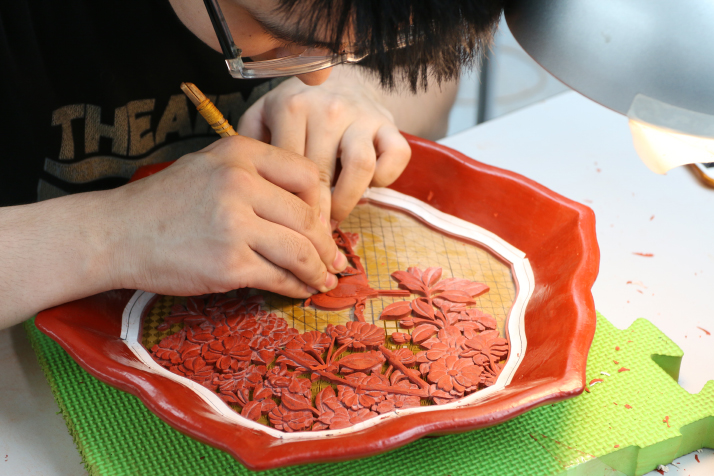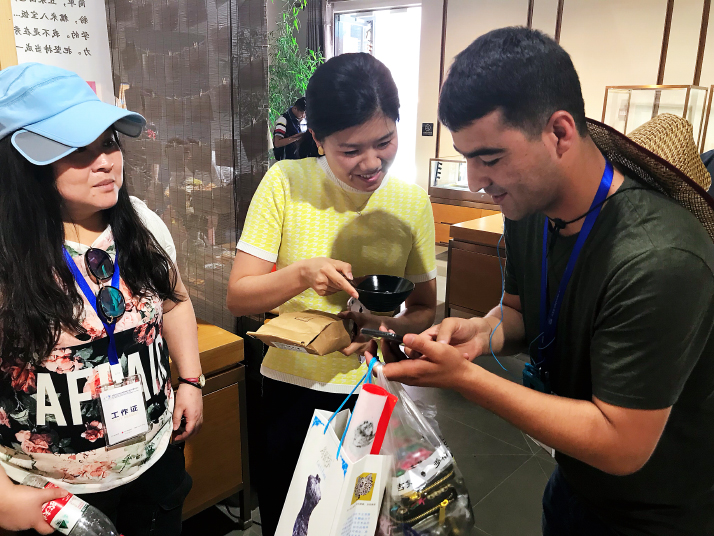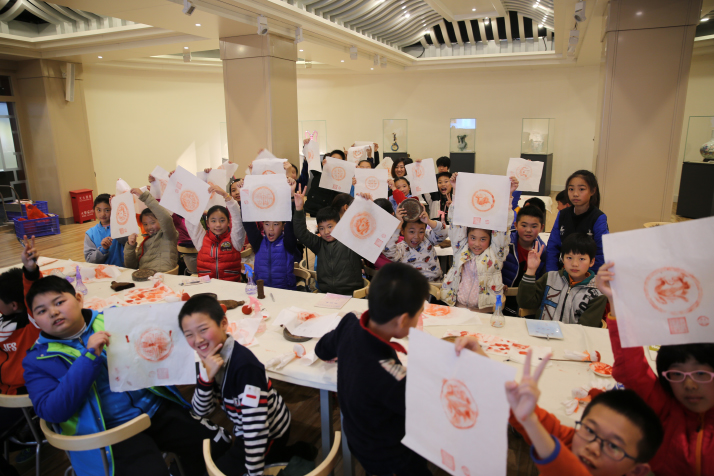| Lifestyle |
| Creative Preservation | |
| Cultural heritage protection takes various forms | |
|
|
 A craftsman from Huafang Culture carves a lacquerware plate on July 3, 2017 (COURTESY PHOTO)
Teapots that combine traditional porcelain-making techniques with modern design, handmade stylish furniture for children made using a mortise and tenon technique, and brooches that incorporate elements of embroidery from the Miao ethnic group mainly living in southwest China. All of these exquisite handicrafts are on sale at the Jiachuan Experience Center in Qianmen, a historical commercial area adjacent to Tiananmen Square in downtown Beijing. Zhang Erze, founder and CEO of the Jiachuan Culture Company in Beijing that owns the Jiachuan Experience Center, said the best way to preserve intangible cultural heritage (ICH) is to make it applicable to people's daily life during a speech at the Beijing International Forum on People-to-People Friendship held on May 27-29. The event, hosted by the Beijing People's Association for Friendship With Foreign Countries, the Beijing Association for Science and Technology, the Communist Youth League Beijing Municipal Committee and the Xicheng District Government, attracted participants from nearly 30 countries. Cultural heritage inheritance and preservation were one of the hot topics for discussion throughout the forum.  A Russian journalist visits the Jiachuan Experience Center in Beijing on May 28 (COURTESY PHOTO)
Spreading cultural traditions Having developed an interest in art and culture at an early age, Zhang decided to delve into the cultural industry by creating Jiachuan in 2017 after having worked as a senior manager at a large tech company for years. Zhang works with both designers of modern artwork and ICH inheritors to bring a modern touch to traditional craftwork. Enthusiasts and potential customers can find access to all of Jiachuan's products at its experience center in Qianmen. Zhang aspires to promote his products by first cultivating customers through reestablishing a family culture for contemporary Chinese families. In Zhang's view, traditional Chinese concepts related to family, whether they were positive or not, have all been lost. For instance, the concept that women should be obedient to their husbands is certainly outdated, but the notion that women should play important roles in coordinating family members' relationships and building a healthy family culture should be maintained. But in reality, both have been discarded. "Some of my friends migrated abroad and their children have become the so-called 'bananas' who neither accept Chinese culture nor are accepted by foreign cultures," said Zhang. "I want my children to be proud of their Chinese identity by rebuilding a family value system." Zhang himself has benefited from his company's embrace of traditional culture and family values. Not only has his dressing style become more traditional, but his relationship with other family members has also become more intimate. When he worked for the tech company, Zhang was responsible for establishing a cloud computing data center in north China's Inner Mongolia Autonomous Region and only returned to Beijing once every two weeks to see his daughter who was still very young. Now he spends more time with his family. Although his startup company has not yet turned a profit, Zhang believes what he will leave to his two daughters will be more valuable than material wealth.  Children showcase their works from an inscription rubbing course at Yuetan Yaji Museum in Beijing on November 11, 2016 (COURTESY PHOTO)
Preserving dying handicrafts The state-owned Beijing Huafang Culture Development Co. Ltd. takes a different approach to cultural heritage inheritance and preservation. Founded in 2012 by acquiring over 20 factories producing traditional handicrafts such as carpets, snuff bottles and carved lacquerware, Huafang works with over 140 ICH inheritors and master craftspeople, producing over 60 categories of craftwork. Yang Weizhi, deputy general manager of the company, said Huafang mainly focuses on preserving traditional handicraft techniques at the moment. "The royal carpets which use golden thread can only be made at Huafang. If we fail to preserve the technique, it will disappear," Yang told Beijing Review. The key to preserving traditional handicraft techniques is to hand them down to younger generations of craftspeople, according to Yang. The company has been recruiting trainees for four years and training them at the Huafang Cultural Creativity Base in the suburban Shunyi District of the capital. However, since the process of becoming a real master takes decades, including an initial training period of three to four years, few young people are attracted to these professions. "Only one fourth of the craftspeople we trained stay in Huafang. Among the dropouts, some have started their own companies, some returned to their hometowns, while others switched to other companies," said Yang. Huafang also offers courses on over 20 categories of traditional handicraft techniques to both children and adults at its Yuetan Yaji Museum in Xicheng, including the making of clay Rabbit God statuettes which are unique to Beijing. The company is also active in international exchanges, for instance, displaying its artwork during the 2018 Winter Olympic Games in PyeongChang, South Korea. However, Huafang still has a long way to go in order to reach global customers, according to Yang. "A viable approach may be using our techniques to make products featuring distinctively foreign cultural elements," he said. Another obstacle is that most of the products the company makes are highly priced and out of reach for average consumers. For example, a piece of carved lacquerware may cost several hundred thousand yuan, making Huafang's customers mostly handicraft collectors. Yang said his company has plans to produce more affordable consumer products in the future. Xicheng, where both Jiachuan and Huafang are based, is one of the two core areas of Beijing with a profound culture and a long history. It is home to 36 national, 67 municipal and 208 district-level ICH items covering folk literature, traditional music, folk sports, fine arts, handicrafts, medical treatment methods, and customs and traditional practices, Yang Fei, Director of the ICH Protection Center of Xicheng, said at the forum on people-to-people friendship in May. In recent years, the center has carried out cultural exchanges with ASEAN countries such as Laos, Cambodia and Singapore to showcase the district's cultural heritage through exhibitions and performances. Copyedited by Rebeca Toledo Comments to jijing@bjreview.com
|
|
||||||||||||||||||||||||||||
|
